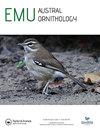Nest predation in Patagonian wetlands: predator assemblage and microhabitat characteristics
IF 1.1
4区 生物学
Q3 ORNITHOLOGY
引用次数: 1
Abstract
ABSTRACT Multiple factors influence predation risk, ranging from habitat conditions to the composition and behaviour of predators. Although these factors are well documented for forest ecosystems, there is little evidence for wetlands, especially within Patagonia. Using artificial nests and camera traps, we documented the nest predation rates and predator assemblage of birds nesting in wetlands of the Patagonian steppe. We also determined the effect of vegetation cover on nest survival and studied the variation in predator groups according to nest placement: nests located in an open wetland, peripheral grassland to the wetland, and nests located in shrubs at different heights. We found 84% of nests failed, counting birds, mice, and armadillos as the main predators. Vegetation cover affected predation events of birds and small mammals, but not those of larger mammals. In turn, small mammals preyed on nests exclusively located in peripheral grassland, medium mammals preferred nests placed in open wetlands, and predation by birds was irrespective of open wetlands and grassland. We also found differences in nest predator assemblage between nests placed on the ground and in shrubs, with birds being the main predators of nests located above ground. These results can be attributed to differential habitat use and movement patterns specific to each predator group. Therefore, the identity, density, and behaviour of predators should be taken into account when planning conservation strategies for birds breeding in wetlands.巴塔哥尼亚湿地的巢捕食:捕食者组合和微生境特征
影响捕食风险的因素多种多样,从栖息地条件到捕食者的组成和行为。虽然这些因素对森林生态系统有充分的记录,但对湿地,特别是巴塔哥尼亚的湿地,几乎没有证据。利用人工筑巢和相机陷阱,我们记录了在巴塔哥尼亚草原湿地筑巢的鸟类的筑巢捕食率和捕食者组合。我们还确定了植被覆盖对巢存活的影响,并根据巢的位置研究了捕食者群体的变化:巢位于开阔湿地,外围草地到湿地,巢位于不同高度的灌木中。我们发现84%的巢穴失败了,鸟类、老鼠和犰狳是主要的捕食者。植被覆盖对鸟类和小型哺乳动物的捕食行为有影响,但对大型哺乳动物的捕食行为没有影响。反过来,小型哺乳动物只捕食位于外围草地的巢穴,中型哺乳动物更喜欢位于开阔湿地的巢穴,鸟类的捕食与开阔湿地和草地无关。我们还发现在地面和灌木上筑巢的巢穴捕食者的组合存在差异,鸟类是地面上巢穴的主要捕食者。这些结果可以归因于不同的栖息地利用和不同的捕食者群体的运动模式。因此,在规划湿地鸟类繁殖的保护策略时,应考虑到捕食者的身份、密度和行为。
本文章由计算机程序翻译,如有差异,请以英文原文为准。
求助全文
约1分钟内获得全文
求助全文
来源期刊

Emu-Austral Ornithology
生物-鸟类学
CiteScore
2.00
自引率
7.70%
发文量
33
审稿时长
>12 weeks
期刊介绍:
Emu – Austral Ornithology is the premier journal for ornithological research and reviews related to the Southern Hemisphere and adjacent tropics. The journal has a long and proud tradition of publishing articles on many aspects of the biology of birds, particularly their conservation and management.
 求助内容:
求助内容: 应助结果提醒方式:
应助结果提醒方式:


